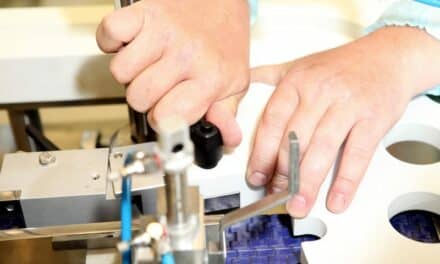By Jeffrey Ruiz
With IoT devices, the advent of artificial intelligence, and various other healthcare technology innovations, one would think that the HTM field would be at the forefront of leading and managing such advances. I know many of my counterparts are doing just that—engaging with technology and discerning how to best use new tools to help improve patient outcomes, while also managing the risk they can bring. However, there are many HTM professionals who still have the “break-fix” mindset—and that concerns me greatly.
Breaking the ‘Break-Fix’ Mindset
Case in point: I recently sent one of my technicians to a service training. When any of my team members attend training, I encourage them to use it as an opportunity to network and share best practices. After all, it’s in those environments that the HTM community has an opportunity to increase its knowledge base and add to best practices.
It’s also a litmus test to see how both our own department and others are operating, so I was disappointed to hear that some of the other departments had not embraced new opportunities in healthcare. Those departments solely focused on the “break/fix” and PM mindset—and IT managed anything outside of that scope. One department started to have a dual CE/IT position, but even that was soon delegated to IT.
I bring up my concerns not to take away from the great work that we have accomplished as an industry with PMs and repairs. I think that, as an industry, we have pretty much mastered PM efficiencies, especially with the various AEM programs that have been implemented. After all, CMS has allowed the HTM community to perform alternative equipment maintenance on devices based on their equipment classifications. Sure, there may be some fine-tuning with these programs, but we are in a technologically advanced period that needs both our HTM expertise and skillset of managing risk to help evaluate how to best utlize these technologies.
Stretching Past the Comfort Zone
How can we do this? Well, first we have to stretch.
I love trail running. It allows me to release the stress of the week and brainstorm ideas. Also, it’s just plain nice to focus on moving one foot in front of another. But before I run, I always stretch. This helps loosen and warm up my muscles to prepare for the hilly or challenging terrain I am about to run. If I didn’t stretch, I could potentially harm myself and, thus, the run would be much less enjoyable. By stretching, I am preparing my body to expand my physical capabilities.
Similarly, stretching in the HTM community will help get us out of our comfort zones. In short, we need to expand beyond our current capabilities. We can do this by learning about what the benefits and risks are with these new technologies. We can reach out to our fellow HTM brothers and sisters and see how they are managing and implementing these technologies. We can also develop relationships with our colleagues in the IT space and see how we can help them.
Everyone Plays a Part
At an individual level, we can also have conversations with hospital leadership and share our own knowledge and insights into these new technologies. For example, if you’re already having conversations on completed PMs and repair statuses, you could take that opportunity to offer ways to help. Or, better yet, ask administrators what questions they may have regarding these new technologies and what challenges they are experiencing. Speaking up individually is really no different than what HTM professionals do each day when rounding with hospital leadership and asking what’s working and what’s not.
Additionally, share your successes—and even your failures—with the HTM community. Share implementation roadmaps or strategies and what worked and what didn’t work. What were your obstacles and challenges? How did you navigate through them, and what would you do differently in the future? These questions will be helpful in guiding your department to expand its role.
Technology is moving fast. We respond every day to our clinical customers for their equipment needs, so who better to help our hospitals navigate these technologies than us? Start small, make it manageable, and use the various resources that we have available in the HTM community. Seek the advice of others and develop your strategies—but also don’t forget to take a deep breath and stretch when you need to.
Jeffrey Ruiz is technology manager for a large hospital, and also is an adjunct professor in the biomedical engineering program at a community college, both in western Michigan. Questions and comments can be directed to 24×7 Magazine chief editor Keri Forsythe-Stephens at [email protected].







Nearly 20 years ago, I realized that computers were going to be a mainstay of HTM and so went and got a master degree IT (Network Security). I have always enjoyed computers and had played with fixing trashed computers since the PC clones hit the market. So what happens when I apply for the various IT positions at where I use to work? Of 6 positions that I applied for, I got interviewed only twice. Three of those IT positions were for the IT security job and I only got interviews the first time. (It was first given to someone with experience but no degree, then someone with a certification and a BA before finally giving it to someone that finally did a good job and stayed, still with a BA and passed the test for a certification but needed the experience.)
From my experience, upper management is doing more to keep HTM from stretching and expanding then the HTM professionals. Even with HTM departments being put under IT management, IT does not seem to think anything of the CBET certification or any of the time a HTM professional get an IT certification.
There also seems to be a blind spot in the area of EMR workers as they are filling them with RNs almost exclusively under the idea that no one else would have the medical terminology for the job. Missing, the fact HTM professionals need to know medical terminology to understand what is wrong with the equipment (and it is tested on all the HTM professional certifications).
HTM is suffering from no one knowing about the profession and the great feeling within the profession that there might be 4 steps up that one can manage in one career and then it is a dead end. A horrible thing to do to a bunch of self motivated, highly trained, often self trained (especially for the most common medical equipment), highly intelligent, very interactive, trouble shooting, technology centric people.
Great article Jeff!
Steve, thanks for the kind words. Just trying to communicate that we have so much opportunity to showcase our unique talents. Thanks!
Good article. I agree with you. As a
Technical Instructor, I see Biomeds from across North America. I am constantly bringing up the fact that devices are becoming integrated,”IT’ed”. I still get students who just want to do PM’s and not worry about systems or networks. Stretching is a good thing. Keep up the good work.
Thanks for the feedback Joe. The more we can get the word out and share each other’s success, the better we have a path for others to follow and develop other own technology strategies. Thanks!
As an x-ray engineer and business servicing diagnostic imaging equipment I feel it is ESSENTIAL that all of our engineers/technicians take computer courses….especially computer Networking courses. I myself learned Networking A+ skills through COMPTIA which is a self study course. Having this knowledge I can figure out if it’s my equipment that is malfunctioning or if it is a hospital networking issue and even if it is a hospital networking/IT issue we are usually able to correct many of the problems that occur….i.e. bad switch ports, mis-configured settings…etc.
Rapid X-Ray
https://www.rapidxray.biz
[email protected]
Having just came back from the AAMI Conference in Cleveland, the IoT was a hot topic and all that is coming with it. To include Networking systems and cyber security. To me there are two big drawbacks to our future. One is, as you stated, Biomeds staying the course of PM and CM only and staying out of sight. The other is a product of this mindset and that is the lack of support from the C-Suite. I too am an adjunct at a community college up in northern Michigan for our Biomed Program here. I have gotten networking into the program and I am working on cyber security also. But in talking with the experts from around the country IT Modalities are not quite Healthcare that Biomeds need. There really needs to be a Healthcare Cyber security and Networking courses specific to what we do. The final piece that is slow to come into play and always has been is the manufacturers training for things like Davinci and the coming AR/VR devices. Biomeds will have to eventually take these up as we have other specialty devices over the decades. We need to become more vocal moving forward within our facilities and with manufacturers. Long gone are the days of Biomed being the silent hero’s. We need to make some noise and step up the game to lead in the technologies that are coming.
I RETIRED AFTER 47 YEARS AND IF THERE’S IS ONE THING THAT I eventually disliked a lot is the IT side of Biomed. I started with PACS in 2001 and it has blossomed to the point where it would take 3 people to handle it properly. The skill sets are different the procedures are different and a DVM is not required. Understanding the choices, picking the right system AND the correct level of contract support is essential. IF installation and workflow are solved early all goes well. AND you MUST be organized. We have to own it totally. This cannot be done without the hospital IT people. It’s their backbone. Getting highly trained IT types into HTM is mandatory. Experience a high priority-but schools can be substituted. BACKUP and disaster plans are far more complicated and crucial to have in place since processing of anything patient related at all cannot take place without everything on-line since everything is on-line. This is stress not solved by a spare physio monitor. New tools, new skills, new outlooks, and a changing demands will keep us stretching for years, but we should have already started the exercise program! Cost$ yes; failure is not an option. Get rid of the doubt; be a lean mean HTM/IT machine. Now, not later. finally, what others have said is right on.
(IMHO) YMMV